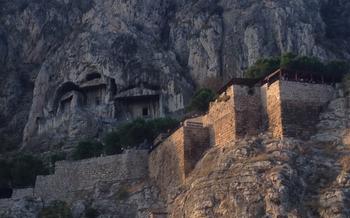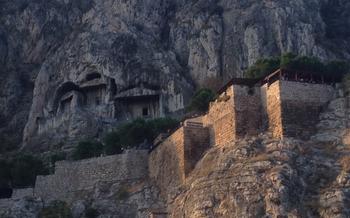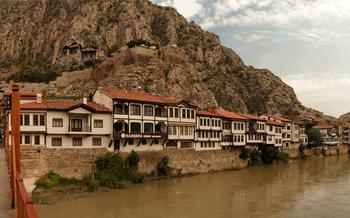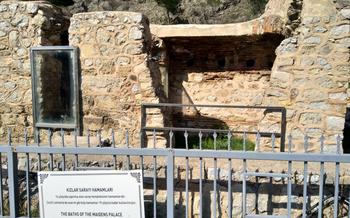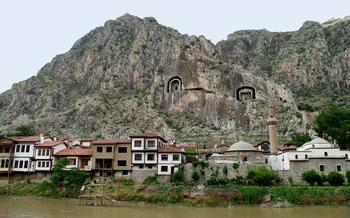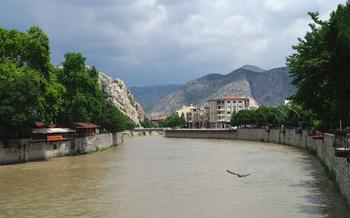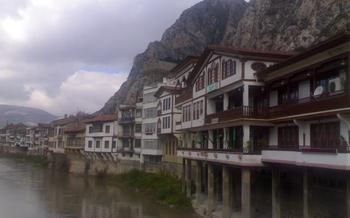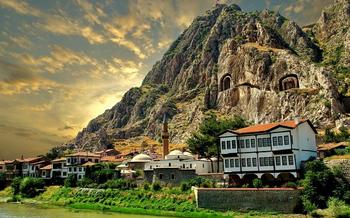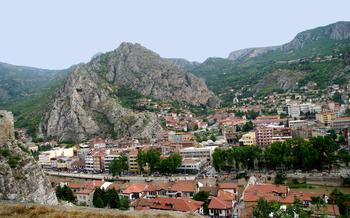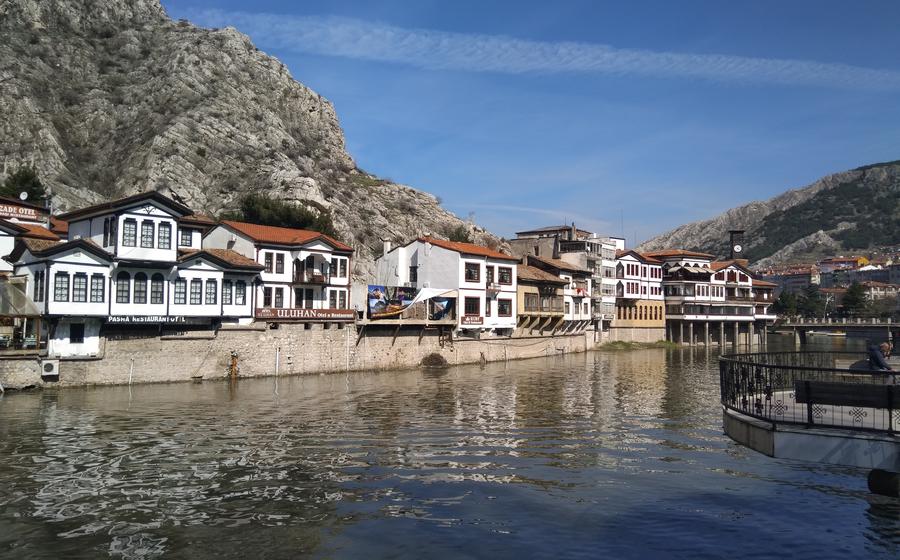
Kumacık Bath
- Historical Significance
- Location and Accessibility
- Hours of Operation and Admission Fees
- Architecture and Design
- Interior Layout
- Services Offered
- Historical and Cultural Importance
- Dress Code and Etiquette
- Recommendations for Tourists
- Local Crafts and Products
- Food and Beverage Options
- Accommodations and Nearby Hotels
- Events and Festivals
Historical Significance
The Kumacık Bath, a magnificent relic of the Ottoman Empire, holds a prominent place in the tapestry of Turkish history. Built in the 16th century during the reign of Sultan Selim II, this architectural marvel stands as a testament to the grandeur and sophistication of Ottoman culture. The bathhouse, nestled in the heart of the picturesque city of Amasya, was once a thriving hub of social and cultural life, serving as a place for purification, relaxation, and communal interaction. Its enduring legacy as one of the finest examples of Ottoman bath architecture has earned it widespread recognition and admiration, solidifying its position as a symbol of Amasya's rich historical heritage.
Location and Accessibility
The Kumacık Bath is conveniently located in the heart of Amasya, making it easily accessible to visitors. Its exact address is Çatalarmut Mahallesi, Sarayönü Caddesi, No: 34, Amasya. To get to the bathhouse, you can take a leisurely stroll through the charming streets of Amasya, enjoying the historic ambiance and local landmarks. Alternatively, you can utilize public transportation, as the bathhouse is well-connected by bus routes. Once you arrive in the vicinity, you will be greeted by the impressive stone facade of the Kumacık Bath, inviting you to step back in time and immerse yourself in its therapeutic waters.
In the immediate vicinity of the Kumacık Bath, visitors can find a treasure trove of other attractions that showcase the rich cultural heritage of Amasya. The Great Mosque of Amasya, with its stunning Seljuk architecture, stands as a testament to the city's Islamic past. The Amasya Museum, housing a diverse collection of artifacts and exhibits, offers a glimpse into the region's fascinating history. For those seeking a picturesque stroll, the Yeşilırmak River, with its lush green banks and serene atmosphere, provides a tranquil escape.
Hours of Operation and Admission Fees
The Kumacık Bath is open to visitors seven days a week. Opening hours are from 8:00 AM to 10:00 PM, allowing ample time for visitors to experience the traditional Turkish bathing rituals.
Ticket prices for tourists are set at a reasonable rate to encourage accessibility. The current ticket price for foreign visitors is 40 Turkish Lira, which includes entrance to the bathhouse and use of its facilities. Children under the age of 6 are admitted free of charge, and discounted rates are available for students and senior citizens.
Additionally, the Kumacık Bath offers various packages and promotions for groups and families. Visitors are encouraged to inquire about these special offers when purchasing their tickets.
Architecture and Design
The Kumacık Bath is an architectural masterpiece that seamlessly blends functional design with aesthetic beauty. Its layout and design reflect the refined artistry and engineering prowess of Ottoman architects. The bathhouse comprises various interconnected rooms, each serving a specific purpose in the bathing ritual.
The central chamber, the sıcaklık (hot room), is the heart of the bath. It features a large, domed ceiling that allows natural light to filter in through small windows, casting a warm, ambient glow on the marble surfaces. The sıcaklık is where bathers would spend most of their time, relaxing and cleansing in the soothing heat.
Surrounding the sıcaklık are smaller rooms, including the soyunmalık (dressing room), where bathers would change into their peshtemals (traditional Turkish towels). The ılıklık (warm room) offered a gradual transition in temperature between the hot and cold rooms, allowing bathers to adjust slowly. The soğukluk (cold room) provided a refreshing contrast to the heat of the other rooms, with cool air and a fountain for rinsing off.
The architectural elements of the Kumacık Bath showcase the intricate craftsmanship and attention to detail that characterize Ottoman architecture. The domes, arches, and vaults are not merely structural components but also decorative elements, creating a sense of grandeur and harmony. The interior is adorned with intricate tilework, geometric patterns, and floral motifs, adding a touch of elegance and artistry to the space.
Interior Layout
The Kumacık Bath is a complex and intricate structure, featuring a series of interconnected rooms and sections, each serving a specific purpose. Upon entering the bathhouse, visitors are greeted by a spacious dressing room, where they can disrobe and prepare for their bathing experience. This room often contains lockers or cubbies for storing personal belongings.
From the dressing room, bathers proceed to the sıcaklık, or hot room. This is the heart of the bathhouse, where the temperature is highest and the steam is thickest. The sıcaklık is typically equipped with a series of marble platforms, where bathers can recline and sweat, allowing their pores to open and toxins to be released.
After sweating in the sıcaklık, bathers move to the ılıklık, or warm room. This room is slightly cooler than the sıcaklık, and it serves as a transition space between the hot and cold rooms. In the ılıklık, bathers can relax and cool down before entering the soğukluk, or cold room.
The soğukluk is the coldest room in the bathhouse, and it is used for cooling down after the hot and warm rooms. The soğukluk often contains a pool of cold water, where bathers can plunge to refresh and invigorate themselves.
In addition to these main rooms, the Kumacık Bath also features a number of other amenities, such as a massage room, a scrub room, and a relaxation room. The massage room is where bathers can receive massages and other body treatments. The scrub room is where bathers can exfoliate their skin using a kese, a traditional Turkish mitt. The relaxation room is where bathers can relax and unwind after their bathing experience.
Services Offered
The Kumacık Bath offers a range of services to enhance the bathing experience and cater to the needs of visitors. Traditional Turkish massage, known as kese, is a popular treatment that involves exfoliating the skin to remove dead cells and impurities. Skilled masseurs use kese cloths and natural soap to cleanse and invigorate the body, leaving the skin smooth and revitalized.
Apart from massage services, the bathhouse provides other amenities for the comfort and convenience of guests. Lockers are available for secure storage of personal belongings, ensuring peace of mind while enjoying the bathing facilities. Towels and other essential items can be rented or purchased on-site, eliminating the need to bring personal supplies.
For those seeking a more immersive and educational experience, guided tours of the Kumacık Bath are available. Knowledgeable guides lead visitors through the various sections of the bathhouse, providing insights into its history, architecture, and cultural significance. These tours offer a deeper understanding of the bathing rituals and traditions practiced in the Ottoman Empire.
Historical and Cultural Importance
The Kumacık Bathhouse holds immense historical and cultural significance, embodying the rich traditions of the Ottoman Empire. During this era, bathhouses served as vital social hubs, where people from all walks of life gathered to cleanse, socialize, and unwind. They played a crucial role in promoting hygiene, health, and well-being within the community.
Bathing rituals in Ottoman society were deeply intertwined with religious and cultural practices. The bathhouse provided a sacred space for purification and relaxation, where individuals could seek solace and rejuvenation. These rituals involved a sequence of steps, including undressing, washing with soap and water, receiving a massage, and enjoying a steam bath.
The Kumacık Bathhouse, with its exquisite architecture and preserved bathing traditions, offers visitors a unique opportunity to experience the authentic essence of Turkish bathing culture. It serves as a living testament to the enduring legacy of the Ottoman Empire and the cultural significance of bathhouses in Turkish society.
Dress Code and Etiquette
Appropriate Attire: When visiting the Kumacık Bath, it is important to dress appropriately to respect local customs and traditions. Swimsuits or revealing clothing are not permitted in the bathhouse. Instead, visitors should wear loose and comfortable clothing that covers the body. Traditional Turkish towels or peshtemals can be purchased or rented at the bathhouse for use during the bathing process.
Respecting Local Customs: It is essential for visitors to be respectful of local customs and traditions while visiting the Kumacık Bath. This includes maintaining a quiet and peaceful atmosphere, avoiding loud talking or disruptive behavior, and refraining from taking photographs of other bathers without their consent. Visitors should also be mindful of the privacy of other bathers and avoid entering any areas that are designated for the opposite gender.
Tips for First-Time Visitors: For first-time visitors to the Kumacık Bath, it is advisable to arrive early to avoid crowds and to allow ample time to enjoy the full bathing experience. It is also recommended to bring your own toiletries and a change of clothes, as these may not be provided by the bathhouse. Additionally, visitors should be prepared to pay a small fee for entrance and any additional services or treatments they may wish to receive.
Recommendations for Tourists
To fully appreciate the tranquility and serenity of the Kumacık Bath, it's advisable to avoid visiting during peak hours, typically in the late morning and early afternoon. Instead, opt for a visit in the late afternoon or evening when the crowds have subsided. This will allow you to soak in the bathhouse's enchanting ambiance without distractions.
A visit to the Kumacık Bath can be seamlessly combined with other attractions in Amasya. The city boasts a rich historical and cultural heritage, with numerous landmarks and sites worth exploring. Consider visiting the Amasya Castle, situated on a hilltop overlooking the city, to delve into the region's fascinating past. The Grand Mosque of Amasya, with its intricate architecture and serene atmosphere, is another must-see. For those seeking a tranquil retreat, the picturesque Yediler Göleti Park, with its seven interconnected lakes, offers a serene haven for relaxation and contemplation.
To capture the essence of the Kumacık Bath's architectural splendor, it's essential to come prepared with your camera. The intricate details and stunning vistas of the bathhouse provide ample opportunities for capturing Instagram-worthy shots. Remember to request permission before photographing any individuals to respect their privacy.
Local Crafts and Products
The Kumacık Bath is not only a place to experience traditional Turkish bathing rituals but also a gem for discovering local crafts and products. Visitors can browse a variety of handcrafted souvenirs and gifts made by local artisans, including intricate pottery, handwoven textiles, and unique jewelry. By supporting these local businesses, you not only take home a piece of Amasya's culture but also contribute to the preservation of traditional skills and livelihoods.
Among the must-buy items are the colorful Turkish towels, known for their softness, absorbency, and vibrant patterns. These towels are a staple in Turkish baths and make for a practical and stylish gift. You can also find an array of hand-painted ceramics, featuring traditional motifs and designs, as well as unique pottery pieces that showcase the creativity and skill of local artisans.
For those looking for something truly special, the Kumacık Bath offers a selection of handmade jewelry, crafted with intricate designs and adorned with semi-precious stones. These pieces are not only beautiful but also unique, making them a perfect gift for a loved one or a cherished memento of your visit to Amasya.
Food and Beverage Options
While exploring the Kumacık Bath, visitors can take a break and indulge in the delectable flavors of Turkish cuisine. The area surrounding the bathhouse offers a plethora of culinary delights, ranging from traditional Turkish dishes to international fare.
For those seeking an authentic Turkish experience, the nearby restaurants serve up a tantalizing array of dishes that showcase the richness and diversity of Turkish cuisine. From savory kebabs and succulent grilled meats to hearty stews and mouthwatering pide (Turkish flatbread), there's something to satisfy every palate.
To truly immerse themselves in the local culture, visitors should sample some of the region's specialties. Amasya is renowned for its delicious apples, which are used to create a variety of sweet and savory dishes, including the famous Amasya Elması Tatlısı (Amasya apple dessert).
For those with a sweet tooth, the local künefe, a delectable pastry made with shredded filo dough, cheese, and syrup, is a must-try. Another popular dessert is Amasya's own Tokat dondurması (ice cream), known for its unique chewy texture and rich flavor.
Whether visitors prefer to dine in a traditional Turkish restaurant or grab a quick bite at a local cafe, the area surrounding the Kumacık Bath offers a culinary journey that will tantalize their taste buds and leave them craving for more.
Accommodations and Nearby Hotels
When planning your visit to the Kumacık Bath, finding suitable accommodations is crucial. Amasya offers a range of options, from budget-friendly guesthouses to luxurious hotels, to suit every traveler's preference and budget.
For those seeking a convenient and immersive experience, choosing a hotel near the bathhouse is recommended. Several hotels are within walking distance, allowing you to easily explore the city's other attractions. Look for hotels that offer traditional Turkish hospitality and amenities such as hammams, spas, and rooftop terraces with stunning city views.
If you prefer a more affordable option, consider staying in a guesthouse or hostel. These establishments often provide basic but comfortable accommodations at a fraction of the cost of hotels. Many guesthouses are located in historic buildings, offering a unique and authentic Turkish experience.
To find the best deals and availability, it's advisable to book your accommodation in advance, especially if you're visiting during the peak tourist season. Online booking platforms and travel agents can help you compare prices and read reviews from previous guests.
Here are some tips for finding affordable and comfortable lodging near the Kumacık Bath:
- Consider guesthouses and hostels for budget-friendly options.
- Look for hotels that offer discounts or packages for extended stays.
- Book your accommodation in advance to secure the best rates.
- Read reviews from previous guests to get an idea of the hotel's atmosphere and service.
- Consider staying in a historic building for a unique and authentic experience.
Events and Festivals
The Kumacık Bathhouse occasionally hosts special events and festivals that offer visitors a unique opportunity to experience Turkish culture and traditions. These events may include:
-
Turkish Bath Festival: Held annually in July, this festival celebrates the history and traditions of Turkish bathing culture. Visitors can enjoy traditional music, dance performances, and demonstrations of bathing rituals.
-
Amasya International Photography Festival: This annual festival, held in September, showcases the work of photographers from around the world. Many of the exhibitions and workshops take place in and around the Kumacık Bathhouse, providing a unique backdrop for the event.
-
Ottoman Heritage Week: Held in November, this week-long event celebrates the rich history and heritage of the Ottoman Empire. Visitors to the Kumacık Bathhouse can participate in guided tours, lectures, and workshops that explore the role of the bathhouse in Ottoman society.
These events provide a wonderful opportunity to learn more about Turkish culture and traditions while experiencing the unique atmosphere of the Kumacık Bathhouse. For specific dates and details, please visit the official website of the bathhouse or the Amasya Tourism Information Center.
